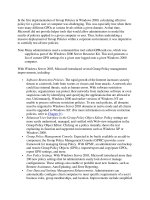UBI-GM-Presentation17-19.050112-mkg n sales ppt
Bạn đang xem bản rút gọn của tài liệu. Xem và tải ngay bản đầy đủ của tài liệu tại đây (1.74 MB, 24 trang )
Personal Selling, Sales Management &
Personal Selling, Sales Management &
International Negotiating
International Negotiating
Chapters 17 & 19
McGraw-Hill/Irwin © 2005 The McGraw-Hill Companies, Inc. All rights reserved.
PowerPoint presentation prepared by:
Alfred Lowey-Ball
Associate Professor of Marketing
UBI-United Business Institutes
Brussels, Belgium
Chapter Outline
•
Designing the sales force
•
Select & Recruit Marketing and sales personnel
•
Training for international marketing
•
Motivating Sales Personnel and Compensation
•
Evaluating and controlling sales personnel
•
The changing profile of the global manager
•
Foreign language skills
•
The pervasive impact of culture on Negotiation
behaviour
•
Implications for managers and negotiators
•
Designing the sales force
•
Select & Recruit Marketing and sales personnel
•
Training for international marketing
•
Motivating Sales Personnel and Compensation
•
Evaluating and controlling sales personnel
•
The changing profile of the global manager
•
Foreign language skills
•
The pervasive impact of culture on Negotiation
behaviour
•
Implications for managers and negotiators
Introduction
•
Global sales opportunities and growing international
competition increases the need for global relationship
marketing, ie on the need to build and maintain long-
term business alliances with partners and customers
•
Building an effective global sales force is crucial for
success in global marketing. The sales person is the
company’s face to the world.
•
Advances in information technology are allow closer
coordination of advertising, marketing research and
personal selling efforts
•
Face-to-face negotiations with foreign governments,
business partners and customers are indispensable for
the implementation of international marketing plans.
•
Be aware of cultural differences and nuances for success
in cross cultural negotiations.
Designing the Sales Force
•
The first step in building a sales force is its
design, which encompasses deciding how many
expatriates, local nationals, or third-country
nationals a particular market requires
•
The hard sell that may work in some countries
can be in inappropriate in others
•
Automobiles have been sold door to door in
Japan for years where “Personal selling as a rule
has to be localized for even the most global of
corporations and industries” (Johanson and
Nonaka 1997)
•
Distribution and selling strategies often vary from country to
country Some markets may require a direct sales force,
whereas others may not.
•
Distribution and selling strategies often vary from country to
country Some markets may require a direct sales force,
whereas others may not.
Recruiting Marketing and Sales Personnel
•
Sales and marketing executives can be recruited
via the traditional media of advertising
(including newspapers, magazines, job fairs, and
the Internet), employment agencies or executive
search firms
•
Many countries restrict the number of non-
nationals allowed to work within the country
citing local management content laws over
concerns
•
The sales force can be recruited from three sources:
(1) expatriates
(2) local nationals, and
(3) third-country nationals
•
The sales force can be recruited from three sources:
(1) expatriates
(2) local nationals, and
(3) third-country nationals
•
To select personnel for international marketing positions
effectively, management must choose individuals who have the
following traits:
•
To select personnel for international marketing positions
effectively, management must choose individuals who have the
following traits:
1. Maturity
1. Maturity
2. Emotional Stability
2. Emotional Stability
3. Breadth of Knowledge
3. Breadth of Knowledge
4. Flexibility
4. Flexibility
5. Cultural Empathy
5. Cultural Empathy
6. Energetic and
6. Energetic and
7. Enjoy Travel
7. Enjoy Travel
Training for International Marketing
•
Selection mistakes are costly, so sales
training is important
•
Training for the expatriates focuses on the
customs and the special foreign sales
problems that will be encountered
•
Expatriates are captives of their own habits and patterns.
Before any training can be effective, open-minded attitudes
must be established
•
Training of local personnel require greater emphasis on the
company, its products, technical information, and selling
methods
•
For global assignments, the aim is to develop employees with
multi-national language skills and multi-cultural awareness
Motivating Sales Personnel
•
Motivation is especially complicated in an international context.
•
The social and competitive contexts require different
motivational systems.
•
Individual financial incentives that work effectively in the
United States can fail in other cultures
•
For example, with Japan’s emphasis on paternalism and
collectivism and its system of lifetime employment and
seniority, employees seem to derive the greatest satisfaction
from being members of a group; so an offer of an individual
financial reward for outstanding individual effort may not work
•
Compensation in European countries typically involve a greater
emphasis on base pay than in the United States, and
performance-based incentives have been found to be less
effective
Relative importance of sales incentives
Designing International Compensation
•
Don’t design the plan
centrally and dictate to local
offices
•
Don’t create a similar
framework for jobs with
different responsibilities
•
Don’t require consistency
on every performance
measure within the incentive
plan
•
Don’t assume cultural
differences can be managed
through the incentive plan
IBM’s list of Do’s and Don’ts
IBM’s list of Do’s and Don’ts
•
Don’t proceed without the
support of senior sales
executives worldwide
•
Allow local managers to
decide the mix between base
and incentive pay
•
Use consistent performance
measures (results paid for)
and emphasis on each
measure
•
Allow local countries
flexibility in
implementations
•
Do use consistent
communication and training
themes worldwide
IBM’s Worldwide Sales Compensation sc
The Future Global Manager
•
Multi-disciplinary education and multi-
functional work experience
–
BA minimal, MBA becoming required.
•
Experience in a number of international
environments
–
Gorrizgueta of Coke (Cuban)
–
Ekkehardt of Compaq
–
Head of P&G US is a Dutchman
–
The head of the Frankfurt Boerse is Swiss
–
The head of Mark & Spencers in UK is Vandevelde (a
Belgian)
•
Multi-lingual:
–
What do you call a person speaking only one
language?
•
Cultural differences in negotiation styles can cause
problems in international at the levels of:
(1) Language
(2) Nonverbal behaviors
(3) Values
(4) Thinking and decision-making processes
The Pervasive Impact of Culture
on Negotiation Behavior
Companies and countries do not negotiate—people do
Companies and countries do not negotiate—people do
Verbal Negotiation Tactics
Verbal & non-verbal bargaining behaviors
1. selection of the appropriate negotiation
team
2. management of preliminaries,
including training, preparations, and
manipulation of negotiation settings
3. management of the process of
negotiations, that is, what happens at
the negotiation table
4. appropriate follow-up procedures and
practices
•
Four steps lead to more efficient and effective international
business negotiations, which include:
•
Four steps lead to more efficient and effective international
business negotiations, which include:
Negotiation Teams
1. Maturity
2. Emotional stability
3. Breadth of knowledge
4. Optimism
5. Flexibility
6. Empathy
7. Stamina
8. Willingness to use team assistance
9. Listening
10. Influence at headquarters
•
Criteria for selecting successful negotiators include:
•
Criteria for selecting successful negotiators include:
Planning For International Negotiations
1. Assessment of the
situation and the
people
2. Facts to confirm during
the negotiation
3. Agenda
4. Best alternative to a
negotiated agreement
5. Concession strategies
6. Team assignments
•
The following checklist ensures proper preparation and
planning for international negotiations:
•
The following checklist ensures proper preparation and
planning for international negotiations:
Negotiation Setting
1. Location
2. Physical arrangements
3. Number of parties
4. Number of participants
5. Audiences (news media,
competitors, fellow vendors, etc.)
6. Communications channels
7. Time limits
•
There are at least seven aspects of the negotiation setting that
should be manipulated ahead of time if possible:
•
There are at least seven aspects of the negotiation setting that
should be manipulated ahead of time if possible:
At the Negotiation Table
•
Nontask sounding
•
Task-related exchange of
information
•
Persuasion
•
Concessions and agreement
•
Differences in the expectations held by parties from different
cultures are one of the major difficulties in any international
business negotiation
•
Differences in the expectations held by parties from different
cultures are one of the major difficulties in any international
business negotiation
•
Everywhere around the world we have found that business
negotiations proceed through four stages:
•
Everywhere around the world we have found that business
negotiations proceed through four stages:
Price Negotiating
•
Learn all you can about the position of the other party
beforehand
•
Learn all you can about the position of the other party
beforehand
•
For each negotiation there is a minimum price that the seller
will accept and a maximum that the buyer will pay
•
For each negotiation there is a minimum price that the seller
will accept and a maximum that the buyer will pay
•
Know that each party will have to give something to get
something
•
Know that each party will have to give something to get
something
•
As seller always emphasize the hidden extra advantages of
the product.
•
As seller always emphasize the hidden extra advantages of
the product.
•
Discuss terms and include them in the final price “package”
•
Discuss terms and include them in the final price “package”
•
Never be in a hurry
•
Never be in a hurry









